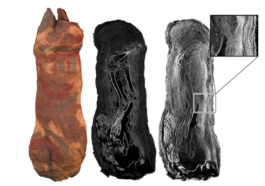archeologist: (also archaeologist) The study of human history and prehistory through the excavation of sites and the analysis of artifacts and other physical remains. Those remains can range from housing materials and cooking vessels to clothing and footprints. The field these people work in is known as archeology.
artifact: Some human-made object (such as a pot or brick) that can be used as one gauge of a community’s culture or history. (in statistics or experiments) Something measured or observed that is not naturally a part of some system. It was instead introduced accidentally as a result of how the measurement or study was performed.
bronze: A metallic alloy that consists primarily of copper and tin, but may include other metals. It is harder and more durable than copper.
Bronze Age: An archeological period that followed the Old and New Stone Ages. It was the first period in which ancient peoples started using metal. When this occurred varied around the world. In China and Greece, it happened at least 5,000 years ago. In Britain it occurred closer to 3,900 years ago. In the early stages, ancient peoples formed copper into useful tools. True bronze, a metal alloy formed from a mix of copper and tin, came later. Tin deposits in southern England led this region to become a major center of Bronze Age culture.
copper: A metallic chemical element in the same family as silver and gold. Because it is a good conductor of electricity, it is widely used in electronic devices.
crop: (in agriculture) A type of plant grown intentionally grown and nurtured by farmers, such as corn, coffee or tomatoes. Or the term could apply to the part of the plant harvested and sold by farmers.
culture: (n. in social science) The sum total of typical behaviors and social practices of a related group of people (such as a tribe or nation). Their culture includes their beliefs, values and the symbols that they accept and/or use. Culture is passed on from generation to generation through learning. Scientists once thought culture to be exclusive to humans. Now they recognize some other animals show signs of culture as well, including dolphins and primates.
iron: A metallic element that is common within minerals in Earth’s crust and in its hot core. This metal also is found in cosmic dust and in many meteorites.
Iron Age: A term for ancient human societies that made great use of iron throughout their culture. This period followed directly after the Bronze Age, and is typically described as starting around the 12 th century B.C. in Greece, India, Iran, and the Middle East. It started later in other parts of Europe and what is now Turkey. This period continued on throughout all of these regions for many, many hundreds of years.
nomad: The name for someone who has not settled into any community or fixed site, but instead lives by moving from place to place over the course of a year in search of food and shelter.
paleolithic: An adjective meaning old stone, it refers to the early Stone Age. This period began about 750,000 years ago and ended about 200,000 years ago. A hunter-gather period, it predates when people began farming.
Stone Age: A prehistoric period when weapons and tools were made of stone or of materials such as bone, wood, or horn. This period lasted millions of years and came to an end around 10,000 to 12,000 years ago.
tool: An object that a person or other animal makes or obtains and then uses to carry out some purpose such as reaching food, defending itself or grooming.








